Special Report
The Holocaust: Countries With the Highest Percentage of Jewish Deaths
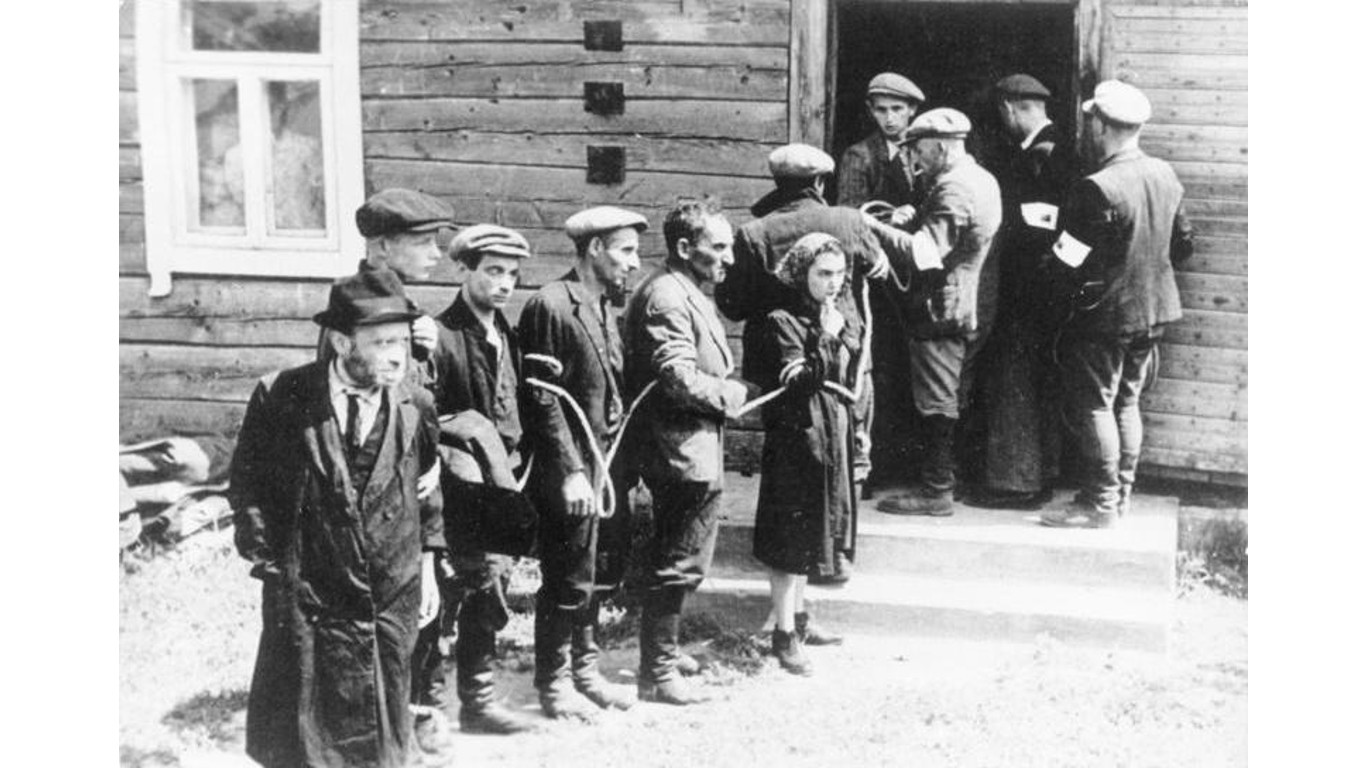
Published:

According to the United States Holocaust Memorial Museum, 6.6 million Jews perished in the Holocaust – some 63% of the 10.4 million in Europe at the time. Nazi Germany tried to impose its “Final Solution” – complete extermination of the Jewish population – on 22 of the nations it occupied or was allied with. The results of this attempted systematic slaughter of the Jews varied by nation. In some countries, the percentage of Jewish deaths nearly fulfilled the Nazis’ quest; in others, a combination of authorities flouting orders, refuge provided by sympathetic non-Jews, and good fortune prevented annihilation. (These are the countries that suffered the most civilian casualties in WWII.)
To determine which countries lost the largest portion of their Jewish populations, 24/7 Tempo sourced data from the United States Holocaust Memorial Museum. Its information is based on estimates and cannot take into account the unknown number of Holocaust victims whose bodies were never recovered or for whom there were no records. Even though the Nazis kept detailed accounts of the people who passed through the camps, they destroyed materials related to the Holocaust in the closing days of World War II. The population data given below ranges from 1937 to 1941.
In nine of the countries on our list, the percentage of Jewish deaths exceeded 68%. Six of these nations were in Eastern and Central Europe, where collaborators or national auxiliaries worked with Nazi death squads assigned to execute Jews. (Many Jews were deported to one of these 25 infamous Nazi concentration camps.)
Not all occupied nations completely knuckled under. Many Jews in Norway received advance warnings of the roundups and fled to neutral Sweden. Forty-two Norwegians have been honored by Yad Vashem, the official Israeli memorial top Holocaust victims, as “Righteous Among the Nations.” When Danes found out that the Nazis planned to deport the country’s 7,500 Jews, they helped nearly all of them escape to neutral Sweden. Italian authorities in Italy and in countries it occupied dragged their feet on deporting Jews even though Italy was allied with Germany.
Click here to see the countries whose Jewish populations suffered the most in the Holocaust
It is worth noting that three European nations with Jewish populations that were either occupied or affiliated with Nazi Germany – Albania, Bulgaria, and Finland – did not lose any of their Jewish citizens to the Holocaust.
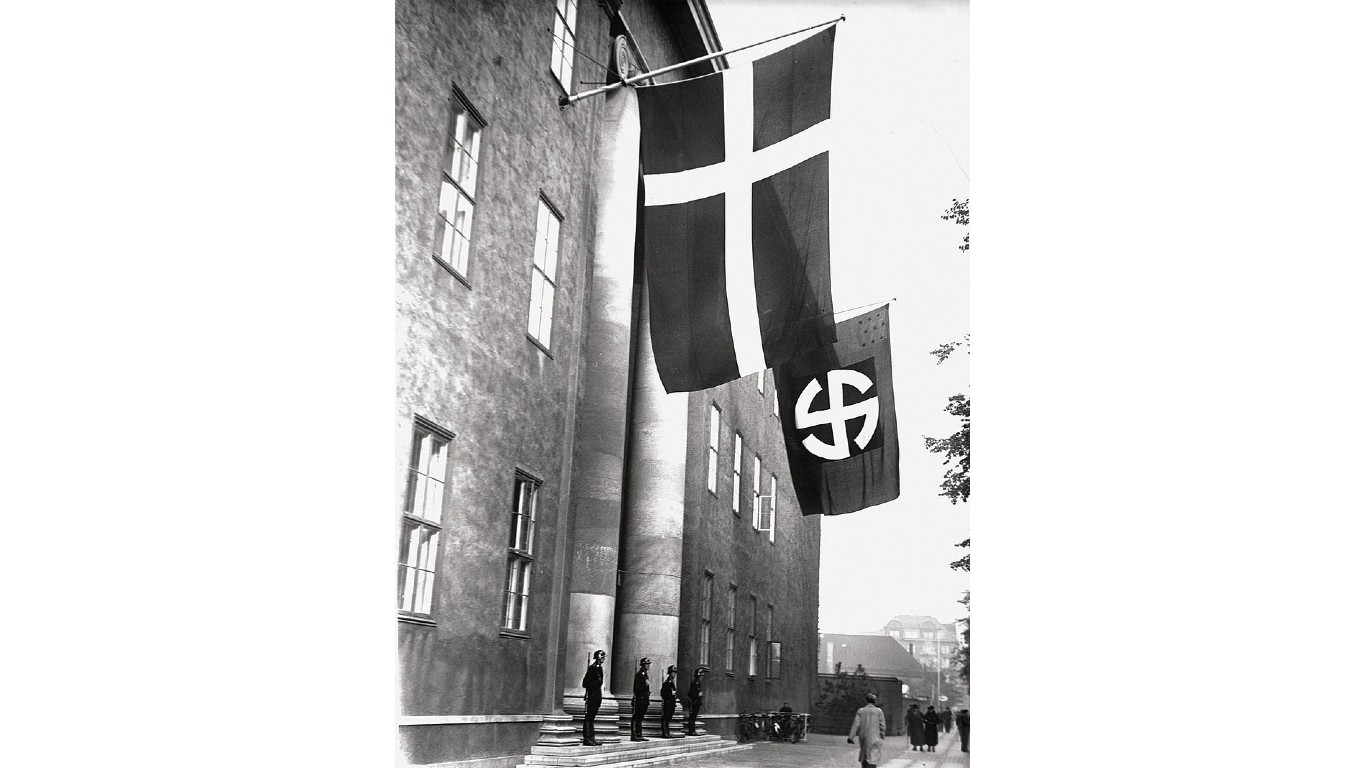
19. Denmark
> Share of Jewish population who died in the Holocaust: 0.69%-1.55% (52-116)
> Pre-war Jewish population: 7,500
> Total pre-war population: 3.8 million
Denmark put up little resistance to the Nazis when German forces invaded the Scandinavian nation in 1940. The Danish government negotiated favorable terms with the Third Reich and Nazi Germany was lenient toward Denmark, at least at first.
After Danish resistance stiffened, the Germans started cracking down. By September 1943, they had dissolved the Danish government and imposed martial law. The Nazi plan was to deport the country’s 7,500 Jews. Their usual practice in other countries was to raid Jewish homes around the Jewish holidays. In Denmark, the Germans targeted Rosh Hashanah as the date to begin deportations, but. Danish citizens got wind of the plan. Over the next few weeks, they helped almost all of the country’s Jewish population cross the Øresund Strait to neutral Sweden.
[in-text-ad]

18. Italy
> Share of Jewish population who died in the Holocaust: 13.5% (7,858)
> Pre-war Jewish population: 58,412
> Total pre-war population: 43.4 million
Benito Mussolini’s fascists took over Italy a decade before the Nazis seized power in Germany, and in an interview with an American rabbi in 1933, the dictator downplayed antisemitism in Italy. The country’s Jews were well-integrated in Italian society by the early 20th century, and feelings against them were not a strong characteristic of Italian culture – though there was certainly antisemitism rooted in the ancient anti-Jewish attitudes of the Catholic Church.
Mussolini did not impose racial laws until 1938, and according to Michele Sarfatti, author of the “Jews in Mussolini’s Italy – From Equality to Persecution,” the dictator did so without being pressured by Hitler. In 1943, however, the fascists began confiscating Jewish property and deporting Jews. Once Italians realized the intentions of the government, many tried to save their Jewish friends and neighbors. The Oscar-winning film “The Garden of the Finzi-Continis” is about an Italian aristocratic family that uses its gardens as a refuge for persecuted Jews.
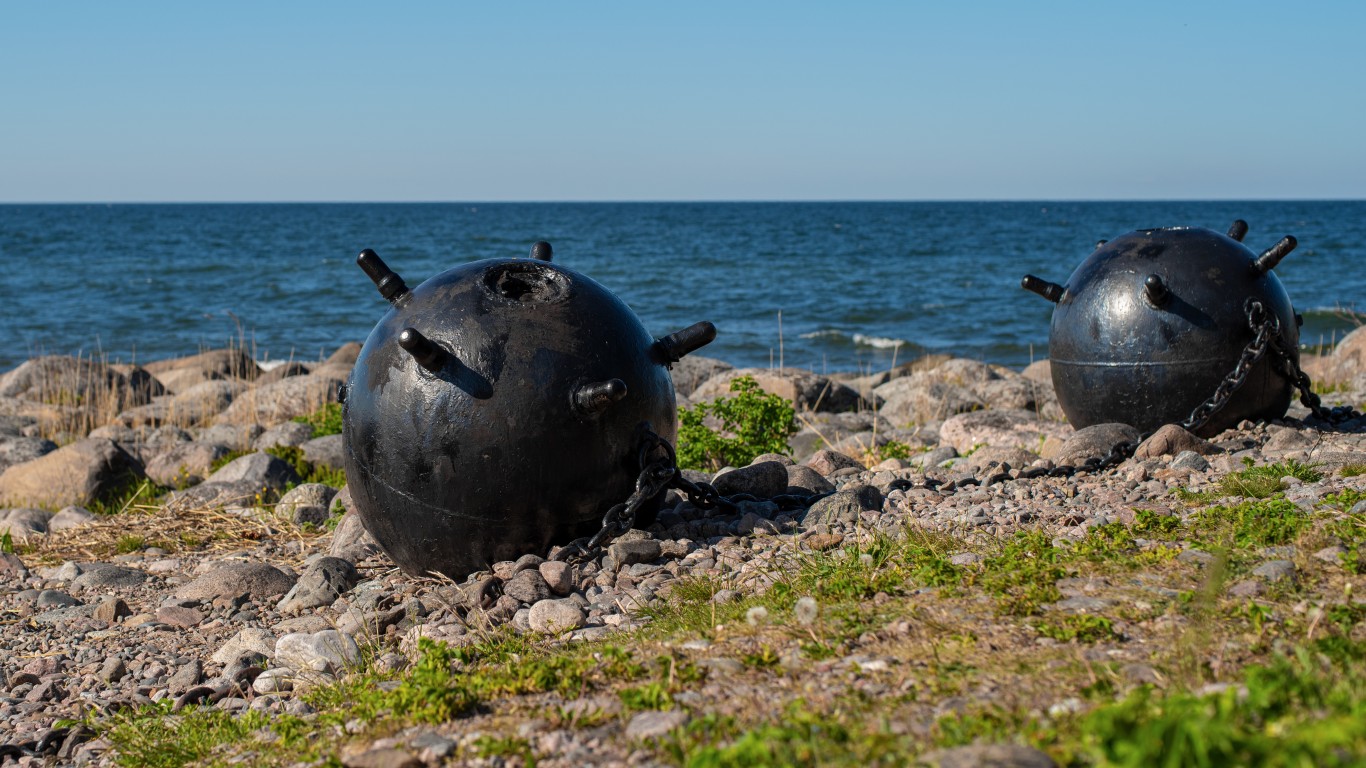
17. Estonia
> Share of Jewish population who died in the Holocaust: 21.4% (963)
> Pre-war Jewish population: 4,500
> Total pre-war population: 1.1 million
The Soviet Union deported about 10% of Estonia’s Jewish population to Siberia just before the Nazi invasion of the Soviet Union in 1941. Many of those who remained fled Estonia after the German invasion. The Nazis utilized Estonian Home Guard and Estonian Auxiliary Police to arrest and execute nearly all the Jews still in the country. Such was their efficiency and the level of participation by Estonians that the Nazis declared Estonia to be Judenfrei – free of Jews.

16. France
> Share of Jewish population who died in the Holocaust: 24.3%-22.4% (72,900-74,000)
> Pre-war Jewish population: 300,000-330,000
> Total pre-war population: 42 million
France was long considered to be one of the more tolerant European nations. In 1791, France became the first country in modern Europe to grant Jews equal rights under the law. Despite such expressions of antisemitism as the scandalous Dreyvus affair in the late 19th century, Jews became well-integrated into French society – at least until France was overrun by the German army in 1940.
With the invasion, most of the nation was split into two zones, the northern part occupied by the Nazis and the southern region overseen by the French fascist Vichy regime. Almost immediately, Jews living in both zones were subjected to antisemitic actions. Jews in the German zone were deported to concentration camps. Initially, the Vichy government only targeted Jewish refugees for arrest and deportation, while seizing the property of native Jews. Beginning in 1942, the Vichy regime, too, began deporting Jews.
[in-text-ad-2]

15. Belgium
> Share of Jewish population who died in the Holocaust: 27.10% (24,387)
> Pre-war Jewish population: 90,000
> Total pre-war population: 8.4 million
From the time Belgium became an independent nation in 1830, it officially recognized Judaism as a religion. Just over 100 years of tolerance in the Low Country ended with the Nazi occupation in May 1940. Many of the Jews in Belgium were refugees from Poland and other countries that were already occupied by the Germans.
The Nazis started deporting Belgium’s German Jews to internment camps in southern France, and then commenced with the deportation of other Jews in 1942, mostly to the Auschwitz-Birkenau concentration and death camp, continuing until the Allies liberated Belgium in 1944. A good percentage of the country’s Jews, though, were hidden and saved by their countrymen.
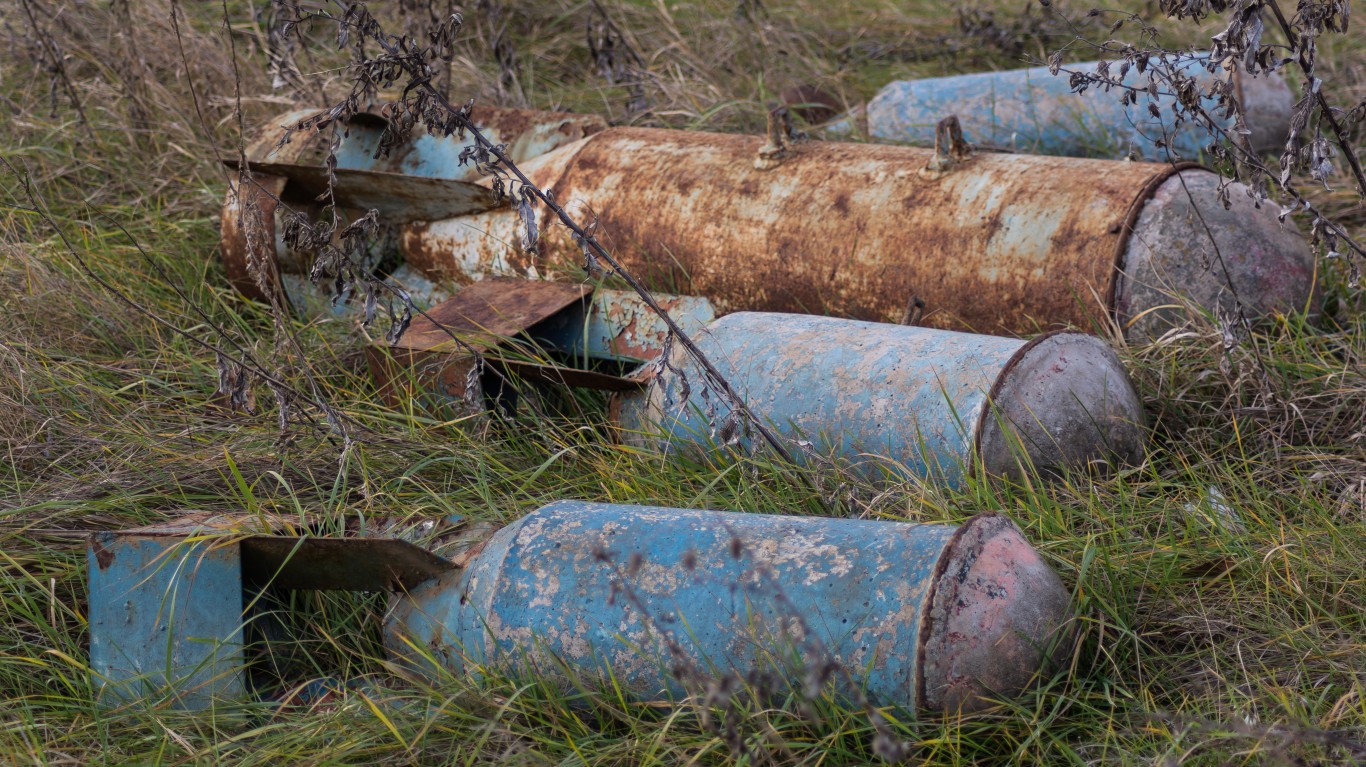
14. Romania
> Share of Jewish population who died in the Holocaust: 28%-34.4% (211,214–260,000)
> Pre-war Jewish population: 756,930
> Total pre-war population: 15.6 million
After Romanian King Carol II was forced to abdicate in September 1940, the fascist leader General Ion Antonescu took power and Romania became allied with Nazi Germany. Antonescu put teeth into antisemitic laws passed by prior Romanian governments. His regime seized Jewish businesses, restricted travel, excluded Jews from professions, and banned them from owning property. The Romanian army and police forces worked with the Nazis to track down and murder thousands of Jews not only in Romania but in annexed or occupied regions. In July 1941, Romania opened its first concentration camp, Chișinău.
[in-text-ad]
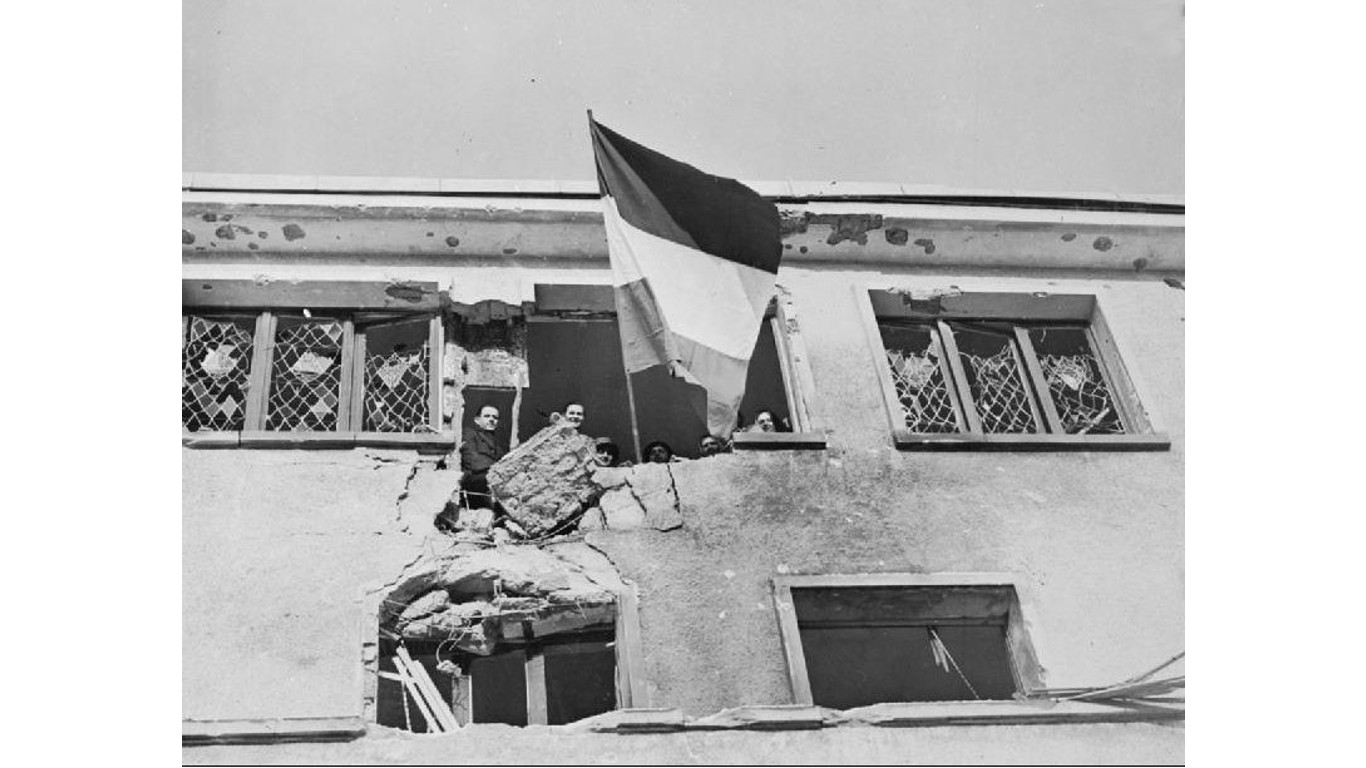
13. Luxembourg
> Share of Jewish population who died in the Holocaust: 34.3% (1,200)
> Pre-war Jewish population: 3,500-5,000
> Total pre-war population: 300,000
The Jewish population in tiny Luxembourg numbered 5,000 at the most, some of them refugees from other countries. Nazi Germany occupied Luxembourg in May 1940. Between August of that year and October 1941 – when the Nazis banned emigration – more than 2,500 Jews left Luxembourg, mostly for unoccupied France, which was nominally more tolerant. Jews from Belgium were deported to concentration camps in Łódź, Auschwitz-Birkenau, and Theresienstadt between October 1941 and April 1943.
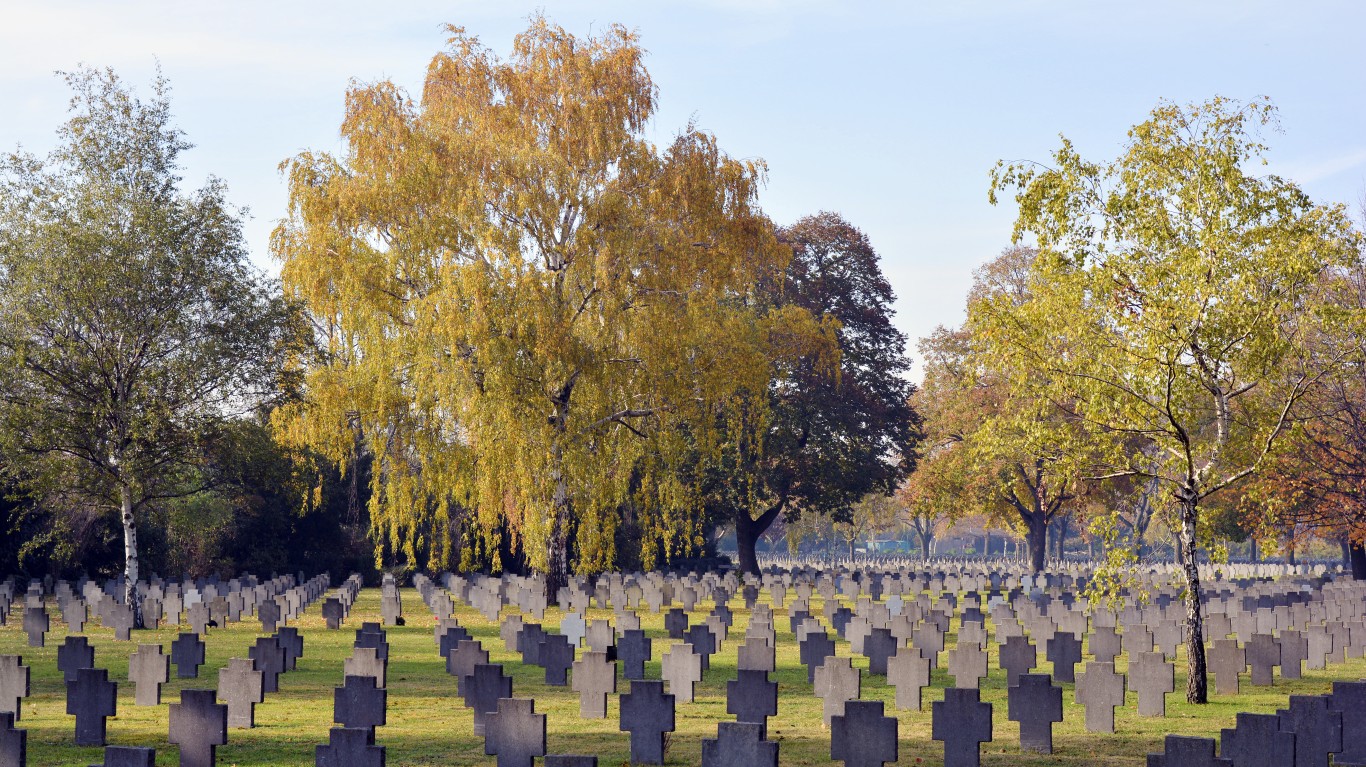
12. Austria
> Share of Jewish population who died in the Holocaust: 35.4% (65,459)
> Pre-war Jewish population: 185,026
> Total pre-war population: 6.8 million
Before World War II, Jews were among the leading lights in Austria’s economic and cultural life. In March 1938, when Germany annexed Austria in the so-called Anschluss (literally “connection”), Jews accounted for almost 4% of the total population, many of them living in Vienna, the nation’s capital. In November, the pogroms that began on Kristallnacht, or the “Night of Broken Glass,” destroyed synagogues and vandalized Jewish businesses in Austria as well as Germany and thousands of Jews were arrested and deported to concentration camps. Jewish emigration surged, and between 1938 and 1940, 117,000 Jews left the country. Further systematic mass deportations from Vienna began in October 1941. About 35,000 Jews were deported from Vienna to ghettos in Eastern Europe, and many were executed by the Einsatzgruppen, or death squads, shortly after their arrival.
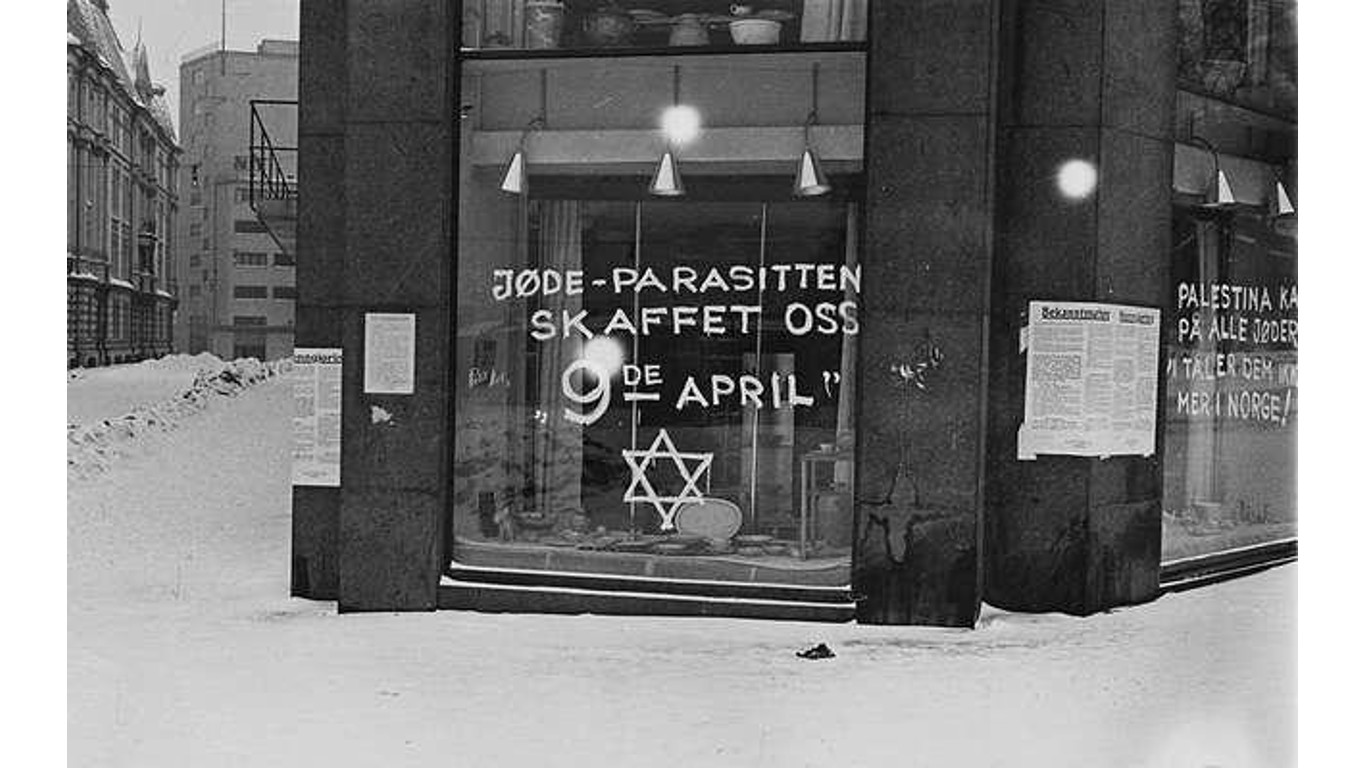
11. Norway
> Share of Jewish population who died in the Holocaust: 42.2% (758)
> Pre-war Jewish population: 1,800
> Total pre-war population: 2.9 million
At the time of the German invasion in April 1940, some of the Jews in Norway were German and Austrian Jewish refugees who had fled to the Scandinavian country in the 1930s. Restrictions on Jews were not strictly enforced until the German invasion of the Soviet Union, when Jews in the northern part of Norway were incarcerated. Arrests of Norwegian Jews spread to other parts of the country, sometimes with the collaboration of Norwegian police and paramilitary groups. Norwegian Jews were deported to the Auschwitz-Birkenau killing center.
Some Norwegian church leaders and segments of the population protested. Many Jews received advance warnings of the roundups from Norwegian police and the Norwegian underground. About 1,000 Jews fled to neutral Sweden. Forty-two Norwegians have been honored by Yad Vashem, the Israeli Holocaust memorial, as “Righteous Among the Nations” – a term honoring non-Jews who risked their lives or freedom to protect Jews from the Holocaust.
[in-text-ad-2]
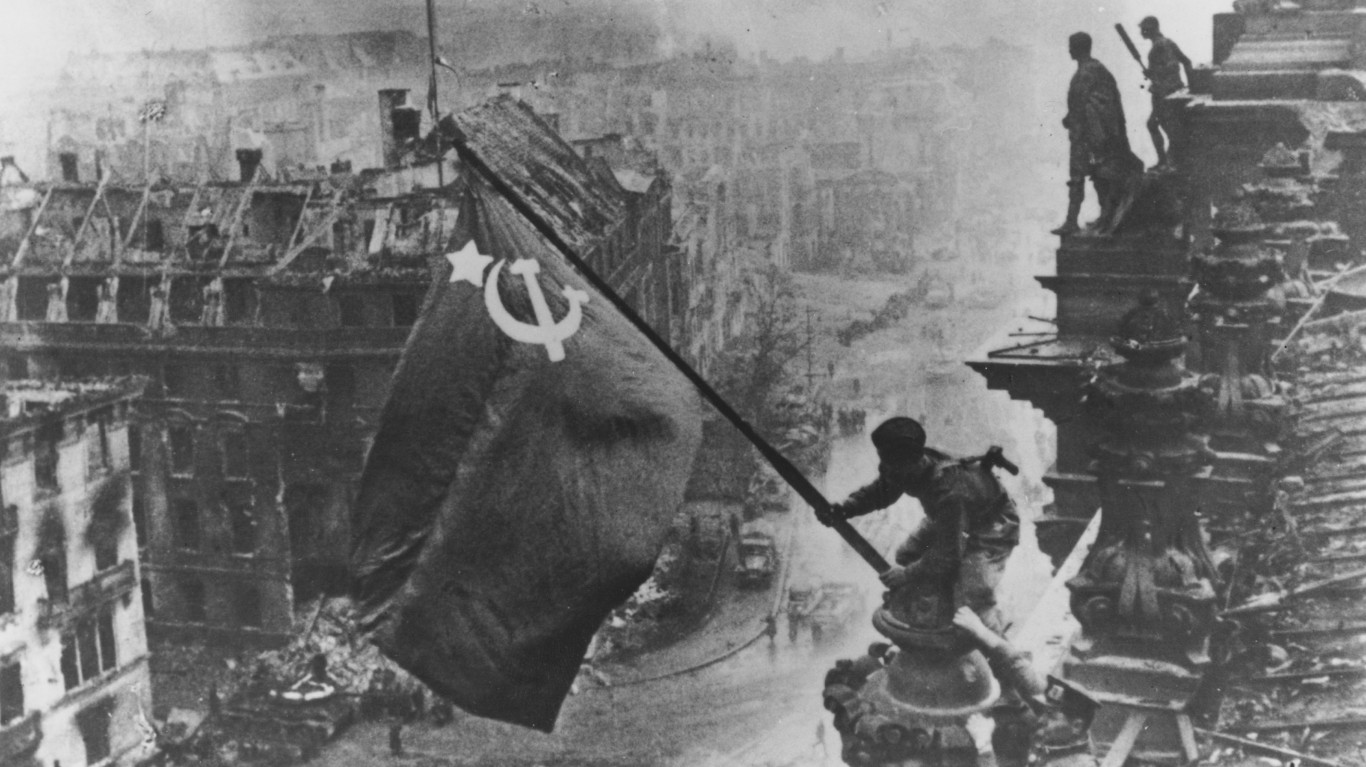
10. Soviet Union
> Share of Jewish population who died in the Holocaust: 44.3% (1,340,000)
> Pre-war Jewish population: 3,028,538
> Total pre-war population: 167 million
Its military objectives aside, the Nazi invasion of the Soviet Union on June 22, 1941, was a racial offensive. The Nazis believed the Slavs to be an inferior people, and because the country was home to more than three million Jews before the war, they thought that conquering the country would be a step toward destroying Jewish influence in the world.
After routing the Red Army in the early stages of the invasion, the Nazis sent in death squads known as the Einsatzgruppen to conduct mass shootings of Jews, communists, and others deemed undesirable. They were supported by army units and local auxiliaries. The systematic slaughter of Jews during the invasion of the Soviet Union was the first stage in Nazi Germany’s “Final Solution” for eliminating all the Jews in Europe. Almost half of the more than 3 million Jews in the Soviet Union would perish.
9. Hungary
> Share of Jewish population who died in the Holocaust: 68.5% (564,507)
> Pre-war Jewish population: 825,007
> Total pre-war population: 9.2 million
Hungary was an ally of Nazi Germany and benefited from its alliance by regaining territory lost after World War I. The Central European nation toed the line in regard to Nazis policies toward the Jews. In 1941, the Hungarian government deported about 20,000 non-Hungarian Jews to Ukraine, where they were murdered by Nazi death squads. However, the Hungarian government refused to deport Hungarian Jews, even though antisemitic laws were in force.
When Hungary sought an armistice with the Allies in 1944, Germany invaded and occupied the country. In March of the year, Adolf Eichmann, SS officer and one of the chief organizers of the Holocaust, was sent in to carry out the extermination of Hungary’s Jewish population of over 800,000 people. Using Hungarian authorities to help achieve this goal, in just over two months, Eichmann set up more than 200 camps and ghettos. More than 437,000 Hungarian Jews were deported in 56 days between May and July 1944, mostly to Auschwitz. Three quarters of them were killed on arrival.
[in-text-ad]
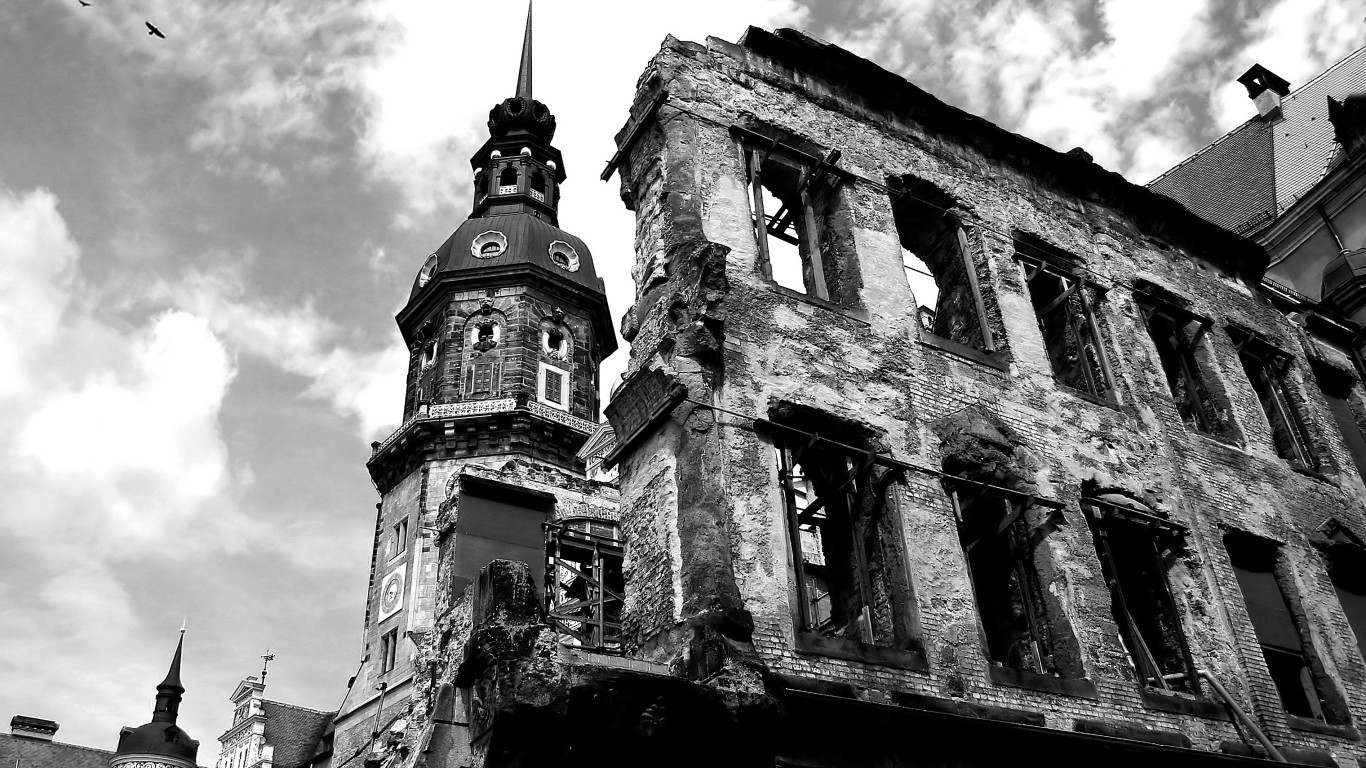
8. Germany
> Share of Jewish population who died in the Holocaust: 69.5% (165,200)
> Pre-war Jewish population: 237,723
> Total pre-war population: 68.6 million
In January 1933, when Adolf Hiter became German chancellor, there were 523,000 Jews living in Germany, half of them in the 10 biggest German cities. Five months later, the population had shrunk to 505,000 because of emigration. Following a succession of restrictive laws and the pogrom known as Kristallnacht, or the “Night of Broken Glass,” in which synagogues were destroyed, Jewish businesses vandalized, and thousands of Jews arrested and deported to concentration camps, the Jewish population in Germany fell to less than 238,000 at the start of World War II.
After the start of the war, Hitler was initially reluctant to deport Jews from Greater Germany because he feared a negative reaction from the German population. But he relented and by September 1941 Germany began deporting Jews. In 1942, top Nazi officials met in the Berlin suburb of Wannsee to discuss ways to deal with ” the Jewish problem.” The so-called “Final Solution” they came up with included the establishment of a network of concentration camps in Germany and other countries that would become infamous in history, including Bergen-Belsen, Dachau, Buchenwald, and Ravensbrück. Almost 70% of Germany’s Jews died in the Holocaust.
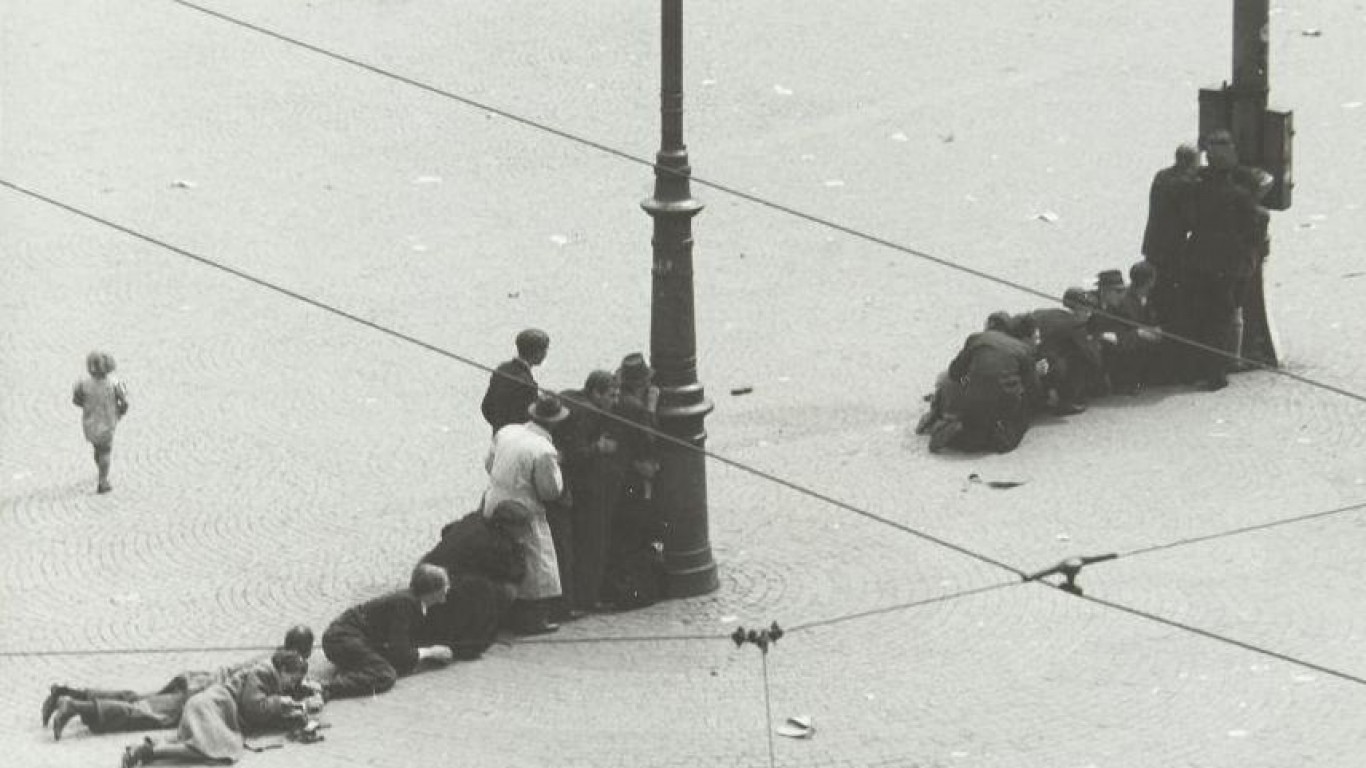
7. Netherlands
> Share of Jewish population who died in the Holocaust: 72.8% (102,000)
> Pre-war Jewish population: 140,245
> Total pre-war population: 8.7 million
Netherlands was overrun by the Nazis in May 1940. They banned Jews from civil service and required them to register their business assets. The Dutch started resisting, and after several hundred young Jews were arrested and sent to Buchenwald and Mauthausen, Dutch workers went on strike – an action that was violently put down by the Nazis.
The systematic deportation of the Jews began in the summer of 1942 and continued until September 1944. Most of the 107,000 who were deported were sent to Auschwitz and Sobibor, where they were murdered. Nearly 73% of the Jews in the Netherlands were killed. Between 25,000 and 30,000 Jews went into hiding in Netherlands, among them teen diarist Anne Frank and her family. Two-thirds of those Dutch Jews who went into hiding managed to survive, assisted by the Dutch underground (though not the Franks, with the exception of Anne’s father, Heinreich).
6. Czechoslovakia
> Share of Jewish population who died in the Holocaust: 73.5% (260,000)
> Pre-war Jewish population: 354,000
> Total pre-war population: 10.5 million
Parts of Czechoslovakia were taken over by Nazi Germany before the start of WWII, and other sections of the Central European nation were annexed by Hungary and Poland. After the German takeover, Jews became subject to the discriminatory laws that mirrored those in Germany. These laws excluded Jews from society and limited where they could travel and work. In November 1941, SS officer Reinhard Heydrich, one of the architects of the “Final Solution,” ordered the creation of the Theresienstadt Ghetto north of Prague. The ghetto served as a transit camp. About 88,000 people were deported from there to Auschwitz, and another 33,000 died from the unsanitary conditions and starvation in Theresienstadt. Nearly three-quarters of Czechoslovakia’s Jews died in the Holocaust.
[in-text-ad-2]
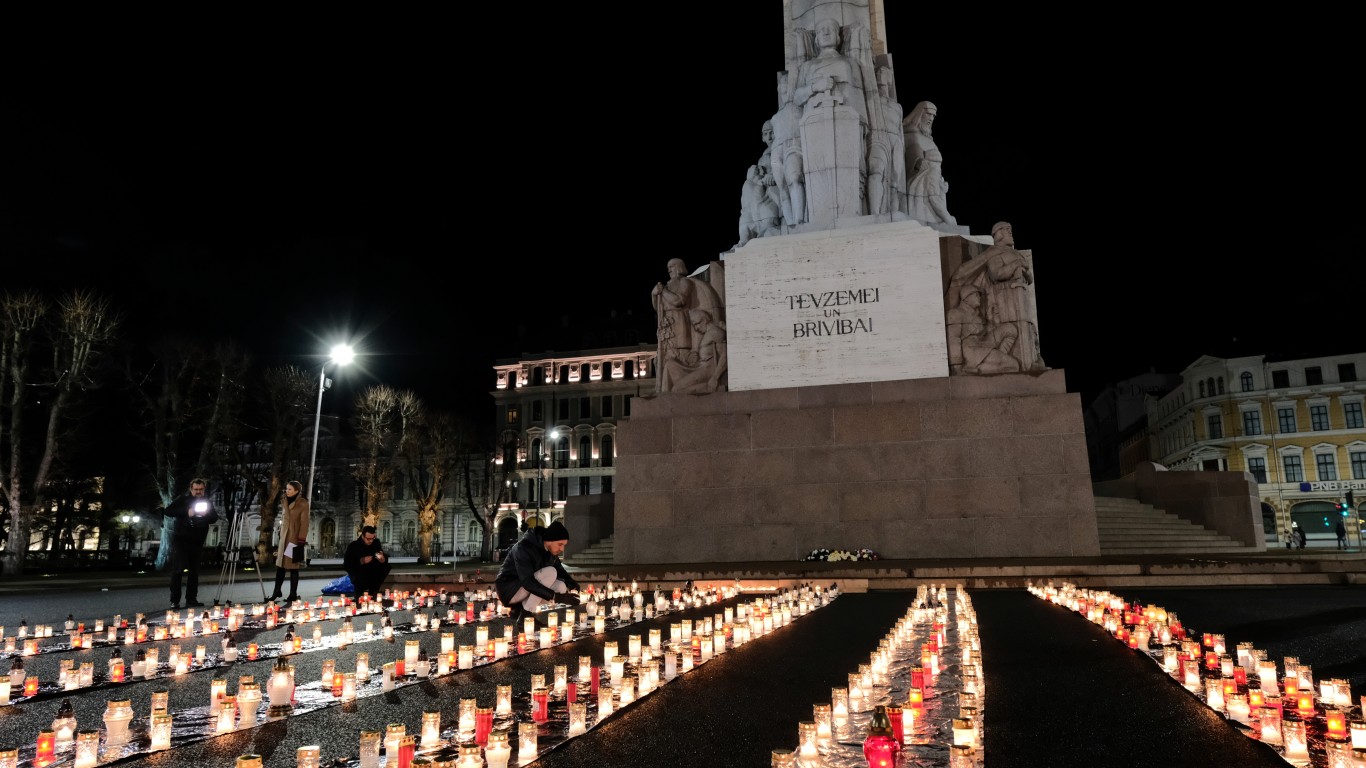
5. Latvia
> Share of Jewish population who died in the Holocaust: 74.9% (70,000)
> Pre-war Jewish population: 93,479
> Total pre-war population: 1.9 million
Latvia is a Baltic country that was independent from the end of World War I until 1940, when it was occupied by the Soviet Union. In 1935, about 94,000 Jews lived in Latvia – about 5% of the total population – roughly half of them in the capital city of Riga, and they were well integrated into Latvian society.
After the Germans invaded in 1941, Einsatzgruppen death squads were dispatched to murder Latvian Jews, aided by Latvian and Lithuanian auxiliaries. Jews were herded into ghettos in the larger cities of Riga, Dvinsk, and Liepaja. The Nazis deported thousands of German and Austrian Jews to the Riga ghetto in 1941 and murdered most of them. In 1944 the Red Army returned to Latvia and expelled the Nazis. A few hundred Jews survived in Latvia, as did several thousand other Latvian Jews who lived through their time in the concentration camps or had escaped to the Soviet Union during the war. In 2021, Latvia’s parliament voted to pay $46 million to the country’s Jewish community for property stolen from it during the Holocaust.
4. Yugoslavia
> Share of Jewish population who died in the Holocaust: 81.8% (67,228)
> Pre-war Jewish population: 82,242
> Total pre-war population: 16.1 million
After Yugoslavia, a nation created after World War I, was invaded by Germany in 1941, the Nazis partitioned it: The Germans occupied Serbia and parts of Slovenia; Italy annexed southern and eastern Slovenia; Croatia became a separate fascist state backed by Germany and Italy; and other areas of Yugoslavia were occupied by Bulgaria and Hungary.
Regardless of the division, Jews in all parts suffered. German military and police authorities in Serbia interned most Jews in detention camps during the summer of 1941. In a ruthless response to partisan activity in Serbia and Bosnia, the German military shot virtually all male Serbian Jews, about 8,000 of them. The next year, the Nazis sent a truck to Belgrade with a hermetically sealed compartment that operated as a gas chamber. Between March and May 1942, they killed around 6,280 people, virtually all Jews and mostly women and children. By the summer of 1942, the only Jews remaining in Serbia were in hiding. The brutality in fascist Croatia was just as terrible. By the end of 1941, Croat authorities had incarcerated about two-thirds of the roughly 32,000 Jews of Croatia in camps throughout the country. The fascist Ustasha regime murdered between 12,000 and 20,000 Jews in the camps 60 miles outside of the Croatian capital of Zagreb. Italians generally balked at German demands to deport Jews from the areas they occupied in Slovenia.
[in-text-ad]
3. Greece
> Share of Jewish population who died in the Holocaust: 82.2%-90.1% (58,800-65,000)
> Pre-war Jewish population: 71,611
> Total pre-war population: 7.1 million
Jews have been in Greece since at least 1492 when they were expelled from Spain and came to the city of Thessaloniki, then a part of the Ottoman Empire. For nearly 500 years they flourished, but the community was almost wiped out after the Germans invaded Greece in 1941. At the time of the country’s occupation by Germany, Italy, and Bulgaria, nearly 72,000 Jews lived in Greece.
Thessaloniki was in the German occupation zone; of 43,000 Jews living there before the war, 40,000 died at the Auschwitz-Birkenau concentration camp. Italians in their zone ignored German demands to kill Jews and in some cases protected them. Jews from the German zone fled to the Italian area but when Italy surrendered to the Allies in 1943, Germany took over the Italian zone and imposed their “Final Solution” there. The Bulgarian authorities turned over the Thracian Jews to the Germans, who deported them to the Treblinka killing center in German-occupied Poland.
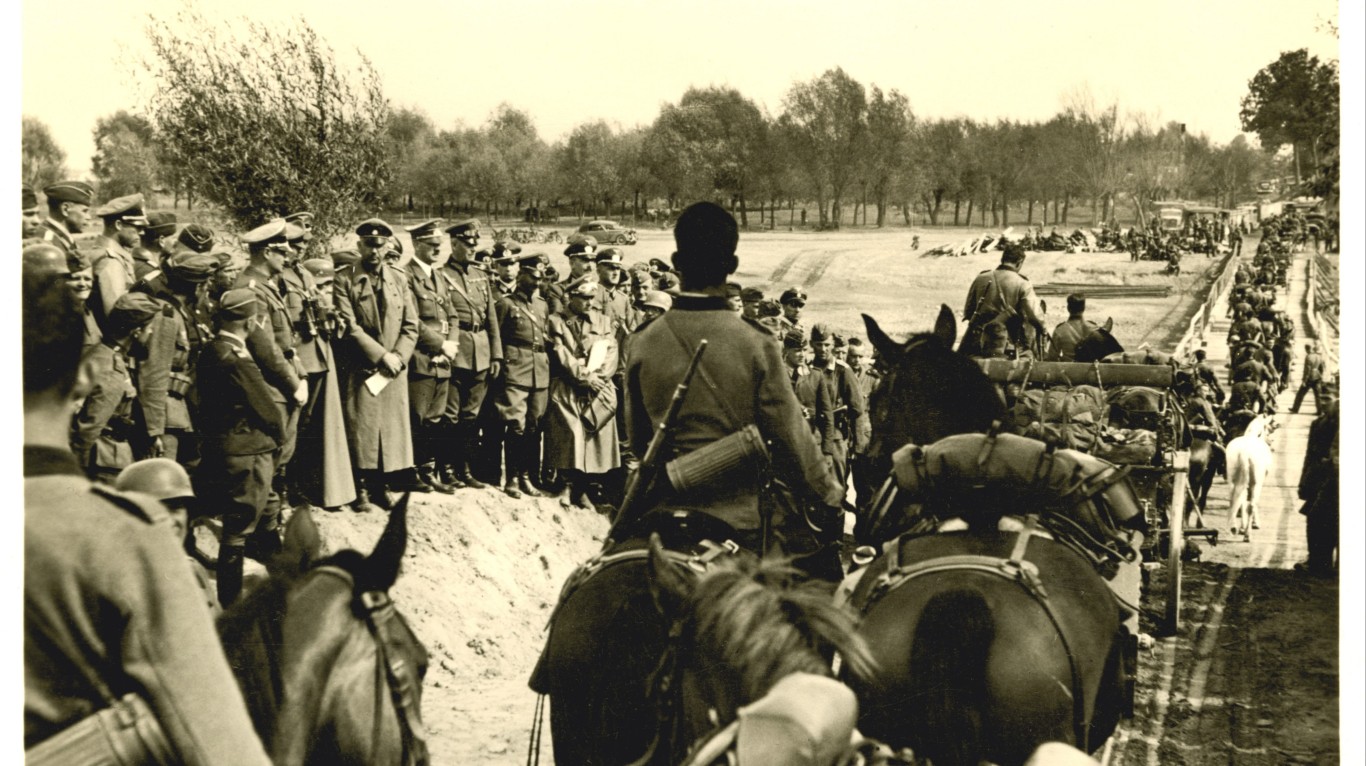
2. Poland
> Share of Jewish population who died in the Holocaust: 82.7%-89.6% (2,770,000-3,000,000)
> Pre-war Jewish population: 3,350,000
> Total pre-war population: 35.1 million
As many as three million of Poland’s Jews died during the Holocaust, far more than those of any other nation. About 10% of Poland’s pre-war population was Jewish, one of the highest in Europe. That was a major reason that the Eastern European nation was in Hitler’s crosshairs, and that Poland was where the Nazis established some of their most notorious concentration camps: Auschwitz-Birkenau, Majdanek, Sobibor, and Treblinka.
The systematic slaughter of Jews in the country did not start until June 1941, when the Germans severed the nonaggression pact with the Soviet Union. The Nazis invaded the Soviet-held part of Poland, and dispatched the killing group called the Einsatzgruppen to murder Jews. It was in German-occupied Poland that the Nazis first began killing with Jews in gas vans. More Jews were murdered in Poland, where they had lived for 1,000 years, than anywhere else. Just 10% of Poland’s Jewish population survived.
1. Lithuania
> Share of Jewish population who died in the Holocaust: 85.0% (130,000)
> Pre-war Jewish population: 153,000
> Total pre-war population: 2.4 million
Lithuania did not have the largest Jewish population in Europe – before World War II, Jews made up only about 7% of the country’s total – but as a percentage, more Jewish people were killed in this Baltic nation than anywhere else during the Holocaust. A major reason was the level of collaboration with the Nazis by non-Jewish Lithuanians.
After Germany invaded the Soviet Union and the Baltic states, detachments of German death squads and Lithuanian collaborators began murdering the Jews of Lithuania. By the end of August 1941, most Jews in rural Lithuania had been slain. Three months later, most of the Jews herded into ghettos in larger cities were massacred. Some Lithuanian Jews were also deported to labor camps in Latvia and Estonia. Others were sent to killing centers in German-occupied Poland. Even as German forces were reeling from Soviet offensives on the Eastern Front, they deported Lithuanian Jews to concentration camps in Germany. By the time the Soviet Union had expelled the Nazis from Lithuania in 1944, at least 85% of Lithuanian Jews had been killed.
Are you ahead, or behind on retirement? For families with more than $500,000 saved for retirement, finding a financial advisor who puts your interest first can be the difference, and today it’s easier than ever. SmartAsset’s free tool matches you with up to three fiduciary financial advisors who serve your area in minutes. Each advisor has been carefully vetted and must act in your best interests. Start your search now.
If you’ve saved and built a substantial nest egg for you and your family, don’t delay; get started right here and help your retirement dreams become a retirement reality.
Thank you for reading! Have some feedback for us?
Contact the 24/7 Wall St. editorial team.